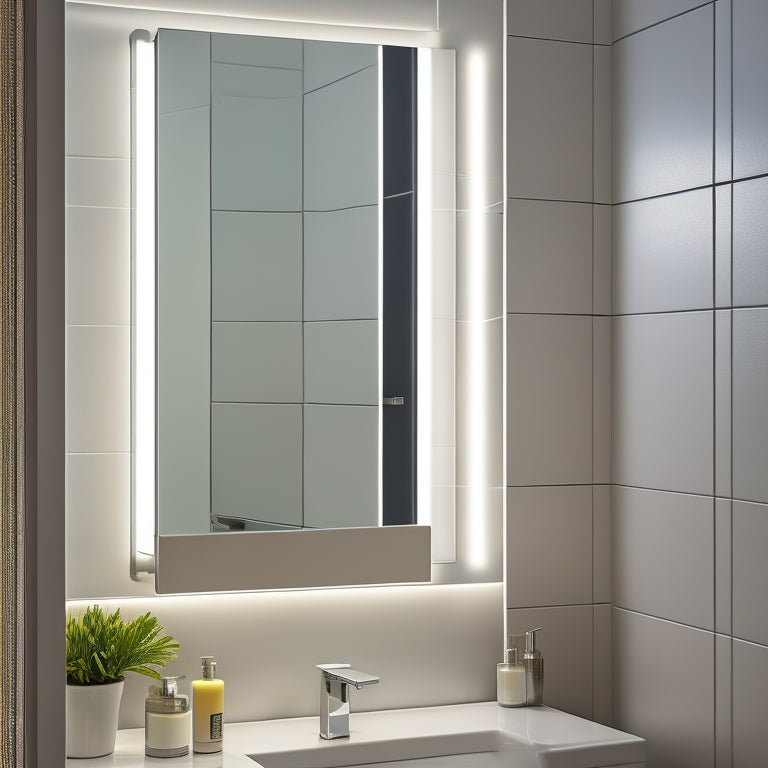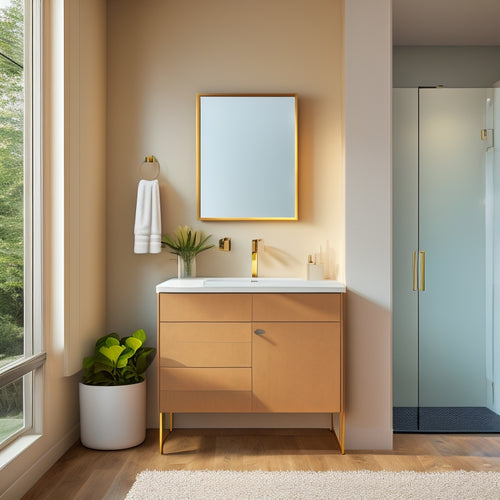
Recessed Medicine Cabinet Installation in the Wall
Share
You're about to initiate a recessed medicine cabinet installation project, which requires careful planning and precision to get it right, especially when it comes to working within the confines of your bathroom wall. You'll need to choose the right cabinet style, evaluate storage needs, and measure the wall for size and material considerations. Then, you'll prep the wall by locating obstacles, inspecting for damage, and ensuring a strong, even surface. With precise measurements and a clean workspace, you can cut the wall opening and install the cabinet, following manufacturer's instructions and utilizing the right tools. Next, you'll refine the details and inspect the finished product, and with each step, you'll uncover more subtleties to achieve a seamless integration.
Key Takeaways
- Measure the bathroom wall accurately to ensure proper clearance for the recessed medicine cabinet's depth and width.
- Confirm the wall material and locate wall studs to guarantee sturdy installation and weight support.
- Mark the wall precisely with a level and pencil to ensure a straight and level cutout for the cabinet.
- Cut the wall opening with a drywall saw or reciprocating saw, following the marked lines carefully to avoid errors.
- Align the cabinet with the wall marks, ensuring the top edge and sides are plumb, and follow the manufacturer's installation instructions.
Choosing the Right Medicine Cabinet
Several factors come into play when selecting the ideal recessed medicine cabinet for your bathroom.
You'll want to take into account the style that fits your space, from modern and sleek to traditional and ornate. Cabinet styles range from simple and understated to elaborate and decorative, so choose one that complements your bathroom's aesthetic.
Beyond aesthetics, think about your storage needs. How much space do you require for medications, toiletries, and other essentials? Look for storage solutions that cater to your specific requirements, such as adjustable shelves, baskets, or drawers.
Additionally, contemplate the type of door you prefer: swing-out, slide-out, or mirrored.
Measure your bathroom wall to determine the ideal size of your recessed medicine cabinet. Verify you have enough clearance for the cabinet's depth and width.
Don't forget to check the material and finish, as they'll impact the overall look and durability of your cabinet.
Preparing the Wall for Installation
Before you begin installing your recessed medicine cabinet, you must confirm the wall is properly prepared to accommodate it. This means verifying the wall materials can support the weight of the cabinet and its contents. Check if your wall is made of drywall, plaster, or another material that may require special considerations.
Next, consider plumbing aspects that may impact your installation. Are there any water pipes or electrical wires behind the wall that could interfere with your cabinet's placement? Use a stud finder to locate these obstacles and plan your installation accordingly.
Take this opportunity to inspect the wall for any damage or weaknesses that could compromise the cabinet's stability. Fill any holes or cracks with joint compound and sand it smooth.
A strong, even wall surface is essential for a successful installation. By taking the time to prepare your wall, you'll avoid headaches down the line and guarantee your recessed medicine cabinet looks and functions as intended.
Measuring and Marking the Wall
With your wall prepared, you're ready to measure and mark the area where your recessed medicine cabinet will be installed. This step requires attention to detail to guarantee a proper fit. Gather your tools required for this task, including a tape measure, level, and pencil.
Take precise measurements of your medicine cabinet, noting its height, width, and depth. Transfer these measurements to the wall, using a level to guarantee the marks are straight and level.
Consider the type of wall materials you're working with, as this may affect the installation process.
- Identify the wall studs to determine the best placement for your cabinet
- Account for any electrical outlets or plumbing fixtures that may be behind the wall
- Double-check your measurements to avoid costly mistakes
Cutting the Wall Opening
You'll need to follow wall measurement guidelines to guarantee your cutout is accurate and level, while considering the cabinet's dimensions and any obstructions like plumbing or electrical outlets.
To make a precise cut, use a high-quality drywall saw or a reciprocating saw with a fine-tooth blade, and contemplate scoring the drywall with a utility knife to prevent crumbling.
Wall Measurement Guidelines
Accurately measuring your wall is essential to create a precise opening for your recessed medicine cabinet. You don't want to end up with a cabinet that's too small or too large for the space. Take your time, and get it right!
To guarantee a perfect fit, consider the following factors:
-
Wall types: Drywall, plaster, or wood - each requires a different approach. For instance, you'll need to account for the thickness of drywall when measuring.
-
Cabinet styles: Will your recessed medicine cabinet have a mirror, lights, or other features that affect its dimensions? Make certain to factor these in when taking your measurements.
-
Obstacles: Are there any pipes, wires, or studs in the way? Identify these potential roadblocks before you start cutting.
Precise Cutting Techniques
Now that you've taken precise wall measurements, it's time to put those numbers to use. You'll need to cut a clean, accurate opening in the wall to fit your recessed medicine cabinet. Don't worry, it's not as intimidating as it sounds. With the right cutting tools and a bit of finesse, you'll be a pro in no time.
First, choose the appropriate cutting tool for your wall material. For drywall, a drywall saw or utility knife will do the trick. For more substantial materials like plywood or MDF, you may need a circular saw or jigsaw. Always wear protective gear, including safety glasses and a dust mask, to avoid injury and mess.
Mark the wall with a pencil, using your measurements as a guide. Double-check your marks to verify accuracy, then start cutting. Apply gentle, consistent pressure, following the marked lines carefully.
Remove any debris or dust as you go, and voilà! You'll have a precise opening, ready for your new medicine cabinet.
Installing the Medicine Cabinet
With the wall opening prepared, hold the medicine cabinet against the wall, confirming its top edge aligns with the mark made earlier, and its sides are plumb.
Double-check that the cabinet's mounting holes align with the wall studs to guarantee a sturdy installation.
Next, use your installation tools to secure the cabinet to the wall. You'll need a drill, screwdriver, and wall anchors to get the job done.
Make certain to follow the manufacturer's instructions for specific installation requirements, as different cabinet materials may have unique needs.
Some things to keep in mind during installation:
- Use a level to confirm the cabinet remains plumb and level throughout the process
- Apply even pressure to the cabinet to avoid damaging the surrounding drywall
- Test the cabinet's doors and drawers to guarantee smooth operation before finishing the installation
Finishing Touches and Final Inspection
Finishing touches require attention to detail to guarantee a seamless integration of the recessed medicine cabinet into your bathroom's design. You're almost done, but don't rush this part – it's vital to get it right.
Start by confirming the cabinet doors align properly and the mirrors are securely attached. Add any decorative accents, such as trim or molding, to conceal any gaps between the cabinet and the wall.
Next, focus on cabinet organization. Install shelves, baskets, or dividers to maximize storage space and keep your bathroom essentials within easy reach. Consider adding a medicine cabinet organizer system to keep your medications and skincare products tidy.
Conduct a final inspection to catch any mistakes or oversights. Check for levelness, plumbness, and secure fastening of all components.
Turn on the lights and inspect the cabinet's reflection to verify it's properly aligned and evenly lit. Take a step back, admire your handiwork, and make any necessary adjustments before calling the job complete.
Frequently Asked Questions
Can I Install a Recessed Medicine Cabinet in a Load-Bearing Wall?
When you're dealing with a load-bearing wall, don't even think about installing that recessed medicine cabinet without considering the weight it'll add - and ensuring the cabinet depth won't compromise the wall's structural integrity, or you'll be in for a real headache!
How Do I Handle Electrical Outlets Behind the Medicine Cabinet?
It's not a coincidence you're thinking about outlets - they're a major concern! You'll need to relocate them to guarantee electrical safety. Hire a pro to handle outlet relocation, or risk getting zapped - literally.
Are Recessed Medicine Cabinets Suitable for Small Bathrooms?
You wonder if recessed medicine cabinets are suitable for small bathrooms; indeed, they're perfect for tiny spaces, offering space-saving benefits and sleek design aesthetics, making your bathroom feel more spacious and stylish, without sacrificing functionality.
Can I Install a Recessed Medicine Cabinet in a Wall With Plumbing?
When dealing with plumbing, you'll need to factor in plumbing considerations, ensuring your cabinet depth doesn't interfere with pipes; measure carefully, as you don't want to be stuck with a cabinet that's more hassle than help!
Do I Need a Permit for Recessed Medicine Cabinet Installation?
You'll likely need a permit, as building codes govern most installations, but don't fret! Research local regulations and follow installation tips to guarantee a smooth process, and remember, it's better to ask than to risk a costly redo.
Conclusion
With your recessed medicine cabinet now seamlessly integrated into the wall, step back and admire the sleek, streamlined look. The mirror's reflective surface seems to blend effortlessly with the surrounding drywall, creating a sense of continuity and flow. The cabinet's subtle presence invites you to open it, revealing a spacious interior that's ready to hold your essentials. Your new recessed medicine cabinet is a proof of your DIY prowess, a harmonious fusion of form and function that enhances your bathroom's style and functionality.
Related Posts
-

Efficient Bathroom Cabinet Solutions With Drawers
You'll be amazed at how cleverly designed bathroom cabinets with drawers can alter your morning routine, providing up...
-

Innovative Tool Empowers Writing With Digital Mapping
Digital mind mapping tools have revolutionized the writing process by providing a powerful platform for conceptual or...
-

Unleash Your Inner Artist With Watercolor Challenge
I'm taking the first step in awakening my inner artist by committing to a watercolor journey that will help me tap in...


